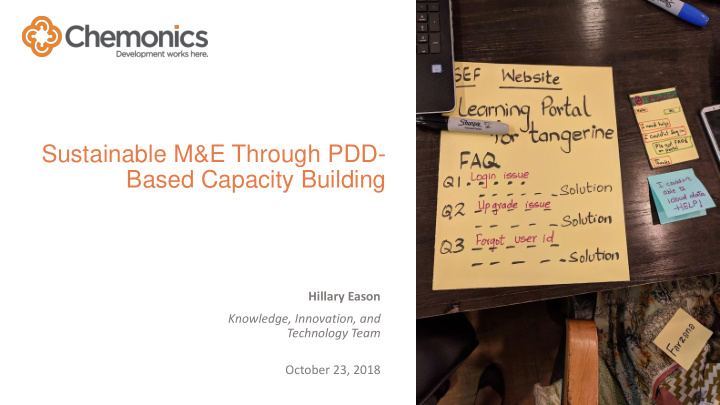



Sustainable M&E Through PDD- Based Capacity Building Hillary Eason Knowledge, Innovation, and Technology Team October 23, 2018
Local partner M&E technology needs don’t always Local Local You partner partner end with your project. Local partner
But just handing over the platforms you use may not be enough. Technology itself changes Project context changes Project scope changes
And your counterparts may or may not be comfortable working with technology. Your counterpart Your M&E tech
So how do you ensure that appropriate and responsible M&E technology continues to be used in the future?
Focus on local capacity-building • Partners should be able to not only use whatever tech you give them, but also choose MEL technology on their own in the future. • There’s a framework available that can help you do just that.
Why use the PDD for this? • Widely accepted • Applicable across a broad cross-section of projects • Easy to understand (even for people with limited tech experience)
What does this look like in practice? Short: session/briefing Long: full workshop • “Here’s how we made these • “Here’s how you can use decisions, keep these the PDD from start to finish Principles in mind” in choosing technology” Medium: training • “Here are some of the Principles that might come up in future”
Case Study: “Choosing and Using Technology” workshop • Context • Done in conjunction with USAID’s Sindh Reading Project • Training was given to a partner NGO, Sindh Education Foundation, as part of a handover process for a custom version of Tangerine (tablet-based assessment tool) • Workshop provided for MEL staff, training team, assessment team, and IT
Case Study: “Choosing and Using Technology” workshop PDD Guidelines for appropriate technology selection GOAL: Partners have the capacity to make decisions about MEL technology in the future. Human-centered design Framework and tools for designing with the user
Case Study: “Choosing and Using Technology” workshop Day 1 Day 2 Day 3 - Introduction to the Principles - Defining Problem, User, - Ideating, Prototyping, Piloting - Context Analysis and Design Criteria - Planning for Sustainability
Case Study: “Choosing and Using Technology” workshop • Each session was driven by specific relevant Principles. Key PDD Concepts: Context Analysis Design with the user. By understanding the basics of • your user groups, you can design something that meets their needs. • Understand the existing ecosystem. A good context analysis will give you information about the local ecosystem you can use in selecting a solution. Be data driven. All of the information in a context • analysis is data you can use to verify your assumptions. Reuse and improve. By looking at past work in this • area, you can identify tools and programs you can build on rather than starting from scratch.
Case Study: “Choosing and Using Technology” workshop • Successes • By the third day, all participants were able to identify the Principles and how they could be used in specific ways to choose new assessment tools • Workshop generated usable ideas and prototypes • Challenges and lessons learned • For a MEL-specific audience, dive deeper into particular relevant principles (e.g. “Address privacy and security”)
FAQ • Can this type of training be used for both MEL and non-MEL partner staff? • Yes! But you may wish to have some MEL-only trainings that focus more on specific Principles, depending on the context. • How much past experience do participants need with technology? • Not much. If they can use a phone, they can learn the Principles.
Thank you! Further questions: heason@chemonics.com knowledgeinnovationtech@chemonics.com
Recommend
More recommend